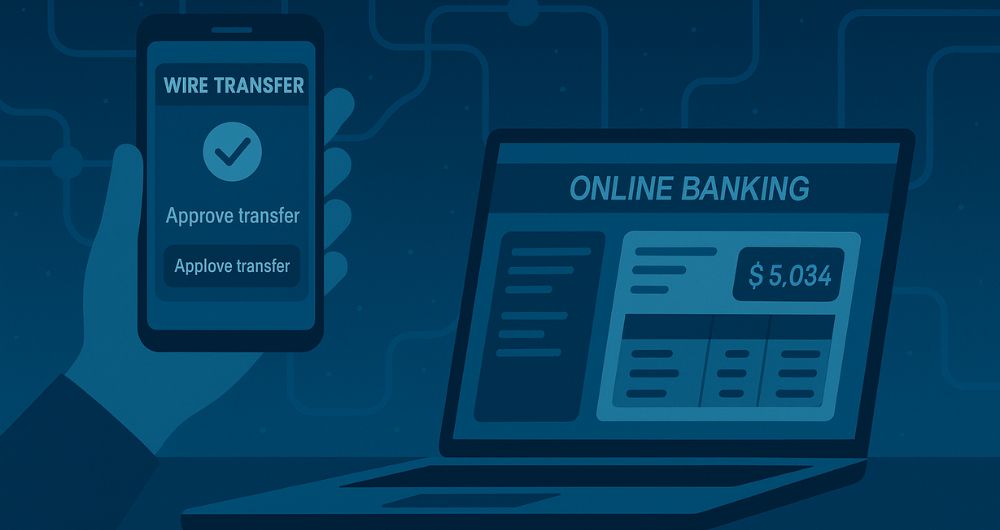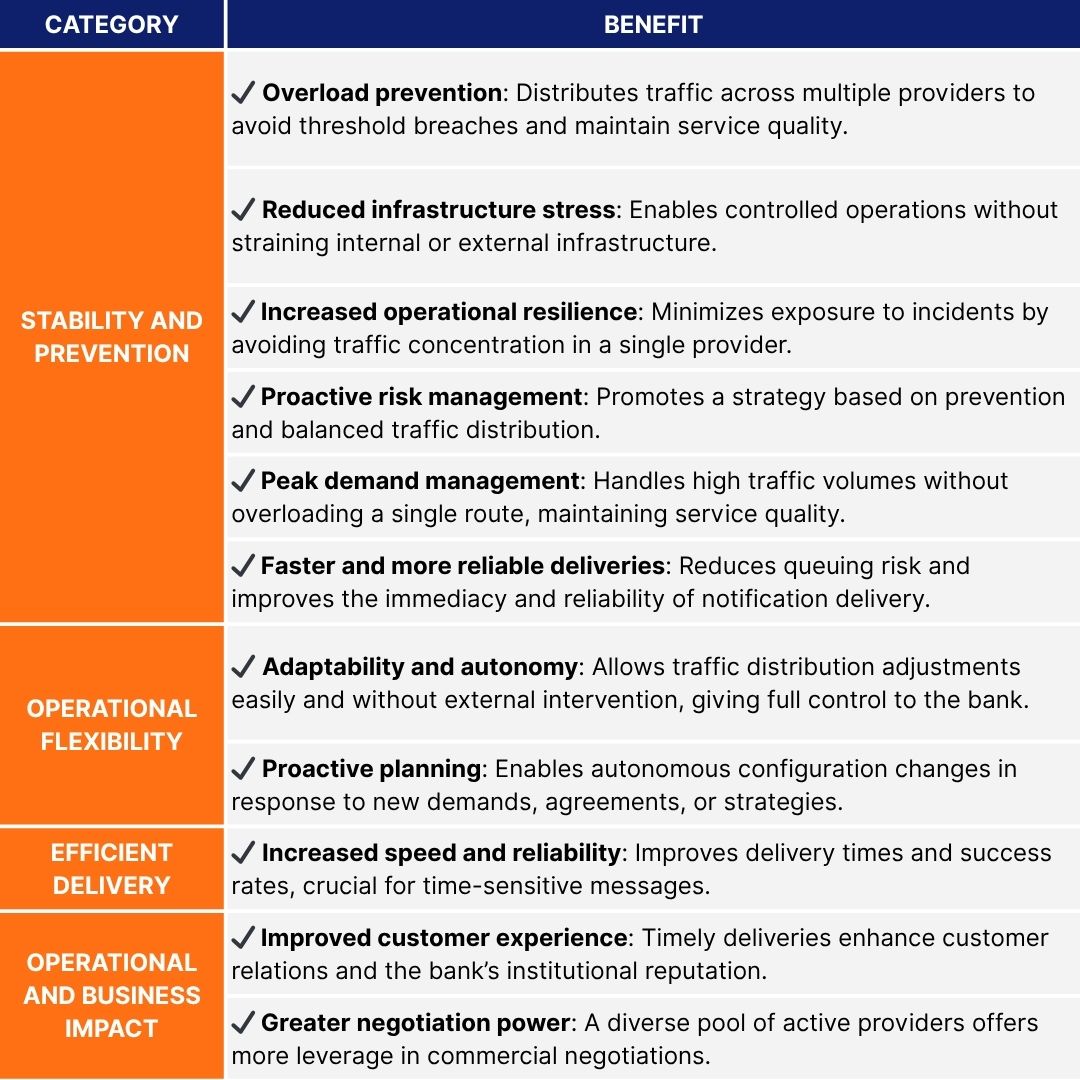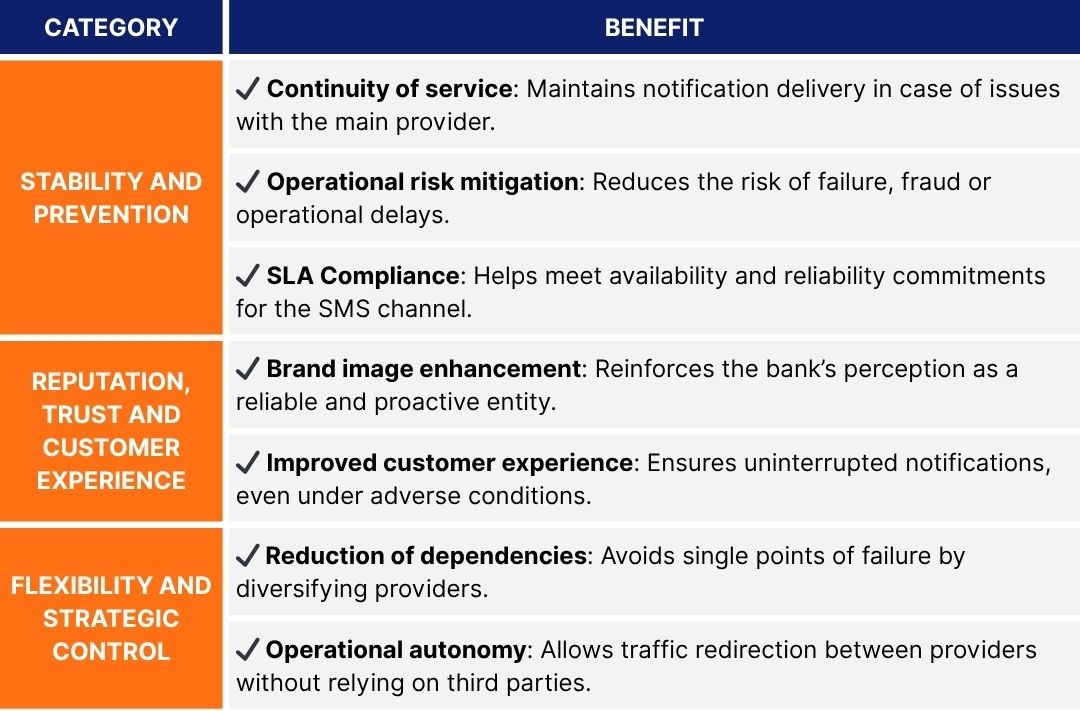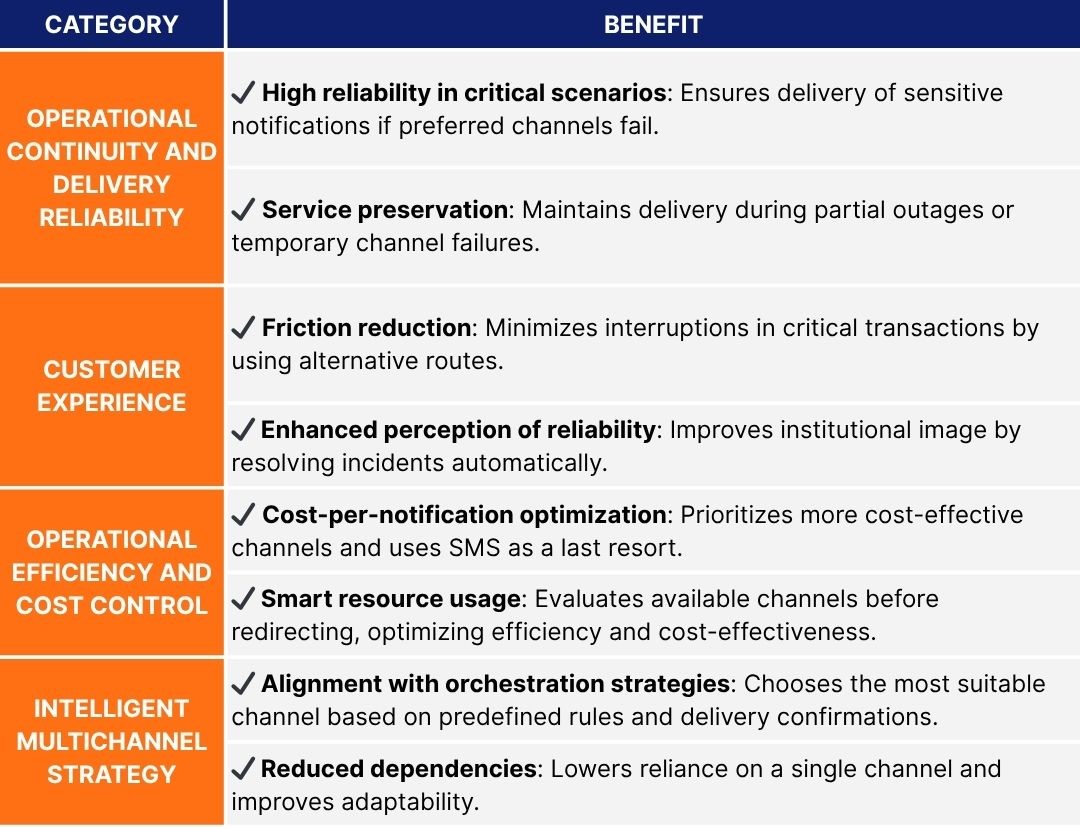
Tools to Ensure Continuity and Quality of Banking Notifications in a Multichannel Environment
What happens when a critical notification doesn’t arrive on time? How does it affect customer trust when a verification code, a security alert, or a transaction confirmation fails to appear?
If a notification fails, the damage goes beyond a missed message: it weakens the bank’s perceived reliability, increases user frustration, and puts both customer trust and security at risk.
Latinia addresses this challenge by offering an architecture designed to handle adverse scenarios, with mechanisms such as Provider Load Balancing, Provider Failover, and Channel Rerouting. These features give banks back operational control, reduce dependency on third parties, and enable the creation of a resilient, automated, and adaptable notification model.
Digital banking has become the primary channel for customer engagement, and real-time notifications are no longer a secondary feature—they are a cornerstone of customer experience, operational security, and business continuity.
Ensuring timely delivery—through the right channel, at the right moment, with full traceability—requires more than just sending a message. It demands that the bank control the entire notification lifecycle and have the ability to adapt in the face of failures or unforeseen circumstances. Operational resilience and service continuity now rely on flexible architectures ready to respond in complex multichannel environments.
In this article, we explore the current challenges of delivering banking notifications across multiple channels and the solutions that make operational resilience and service continuity possible. These are capabilities banks can activate with Latinia as a channel orchestrator, allowing them to make the most of their own infrastructure and maintain a robust, efficient, and uninterrupted service.
Today’s challenge: Ensuring continuity and quality in a multichannel environment
Banks now operate within a complex digital ecosystem, where customers expect to be notified in real time through the channel that best fits the context—whether it’s a mobile app, email, SMS, or even WhatsApp. This variety of channels becomes a challenge without a clear strategy for managing them efficiently.
Operational resilience and service continuity can no longer rely solely on whether a provider delivers a message or not. What truly makes the difference is the bank’s ability to maintain control over the entire process—from the moment an event is triggered to the successful delivery of the notification, regardless of external conditions or the channel used.
In this new landscape, making sure each message is delivered on time and through the right channel requires resilient, traceable, and adaptable architectures. It means rethinking the traditional communication model and recognizing that notifications are not just a technical component, but a vital part of the customer experience and banking operations.
How to overcome the limitations of the traditional approach
For years, many institutions have relied on channel providers to deliver critical notifications. These providers are essential partners in customer communications and play a key role in the final delivery of messages.
Latinia’s goal is to strengthen that partnership by adding an extra layer of intelligent management. This way, banks and providers work together to ensure effective, traceable, and resilient delivery—even under adverse conditions.
With this joint approach, Latinia and channel providers help address the challenges banks often face when managing critical notifications, such as:
- Lack of visibility and control over what happens before and after a message is sent.
- Inability to react immediately if the channel fails or doesn’t confirm delivery.
- No way to apply custom logic or prioritize messages based on their level of urgency.
- Operational decisions that depend on third parties, reducing autonomy and slowing response times during incidents.
Latinia enhances the notification strategy by providing greater control, monitoring capabilities, and failure response. This allows banks to protect sensitive operations—such as authorizations, authentications, or security alerts—and deliver a better customer experience.
Regaining control: The value of multichannel orchestration
Overcoming these limitations requires a shift in mindset: it’s not about replacing providers, but about equipping the bank with an intelligence and governance layer that enables real-time decision-making in every situation. This is the core function of effective multichannel orchestration.
Managing notification delivery isn’t just about sending messages—it’s about activating the right resources—providers, channels, routes—based on conditions defined by the bank. It’s about maintaining control over what is communicated, how it’s communicated, under what rules, and how the message’s journey is preserved, even when the environment is unstable or experiencing failures.
This kind of architecture enables banks to:
- Make dynamic decisions based on channel availability and response.
- Define priorities, business rules, and automated fallbacks.
- Reduce dependence on third parties without losing access to their capabilities.
- Preserve traceability and audit every step of the process.
In this model, Latinia acts as a strategic layer that empowers the bank to regain control by coordinating available resources and activating mechanisms that ensure efficient, continuous delivery aligned with business logic. Next, we’ll explore how this resilience-driven architecture translates into specific mechanisms that support reliable delivery.
Key features to ensure service continuity and quality
To guarantee reliable notification delivery in multichannel environments, banks need to activate mechanisms that can respond effectively to outages, traffic spikes, or isolated failures. As a channel orchestrator, Latinia enables the implementation of these capabilities without relying on a single provider or compromising operational efficiency.
Provider Load Balancing
When a financial institution works with multiple SMS providers—whether for technical, commercial, or capacity-related reasons—Latinia enables the activation of Provider Load Balancing. This feature allows the bank to define a random traffic distribution scheme across different providers, based on pre-configured percentages set by the institution.
The distribution logic is fully customizable and does not depend on the message content or its level of urgency. For example, a bank may choose to route 70% of messages through one provider and the remaining 30% through another, adjusting the distribution according to operational needs or existing agreements.
This feature helps optimize the use of available resources and enables proactive, balanced SMS channel management—especially in high-demand scenarios.
Benefits of Provider Load Balancing

Provider Failover
In the banking environment, the SMS channel plays a critical role in customer communication processes. In certain situations—such as scheduled maintenance or technical issues—it may be necessary to temporarily reroute message traffic through an alternative provider to maintain service continuity.
Latinia enables the activation of SMS Provider Failover, a feature that allows banks to manually switch SMS traffic in real time from one provider to another. This mechanism supports both unplanned events and scheduled interventions, based on the predefined routing configurations set by the institution.
With this feature, the bank retains control over the SMS channel and strengthens its ability to respond in environments where availability, performance, and adherence to service level agreements are essential.
Benefits of Provider Failover

Channel Rerouting
While some delivery issues originate with messaging providers, there are also situations where the channel itself fails to guarantee delivery—a push notification isn’t received, an email bounces, or delivery isn’t confirmed. To address these scenarios, Latinia includes the Channel Rerouting feature, designed to preserve notification delivery when the preferred channel does not confirm receipt.
This mechanism ensures the delivery of critical notifications when preferred channels—such as push, email, or WhatsApp—fail to confirm reception.
It operates on a wait-and-forward logic: if no confirmation is received from the preferred channel within a defined time frame, the notification is automatically redirected to an alternative channel. The system prioritizes cost-efficient channels and reserves SMS as a last resort.
The goal of Channel Rerouting is to ensure that critical notifications reach the customer through a valid channel, even when the primary option encounters issues. This approach maintains communication continuity and reinforces the quality of service perceived by the customer.
Benefits of Channel Rerouting

From complexity to efficiency: A new way to manage banking communications
Ensuring continuity and quality in notification delivery is no longer optional in digital banking—it’s a critical responsibility that directly impacts customer trust, operational security, and service efficiency. In an increasingly complex and multichannel ecosystem, sending messages is not enough: banks must intelligently orchestrate available resources to ensure that every notification is delivered on time, through the right channel, and with full traceability.
Latinia addresses this challenge with an architecture built for adverse scenarios, offering mechanisms such as Provider Load Balancing, Provider Failover, and Channel Rerouting. These features enable banks to regain operational control, reduce dependence on third parties, and build a resilient, automated, and adaptable notification model.
The result: a stronger customer experience, faster response to incidents, and a measurable improvement in the quality of financial services.
Want to strengthen the continuity and quality of your banking notifications? Learn more about these and other features, speak with a Latinia expert, or visit our website for further details.
Categories: Cloud & Tech
